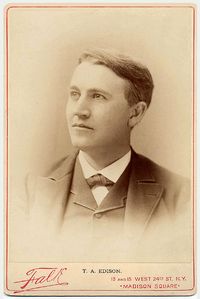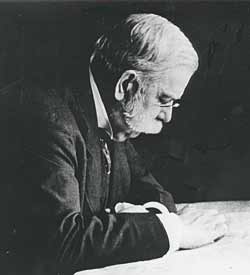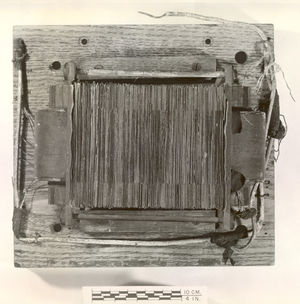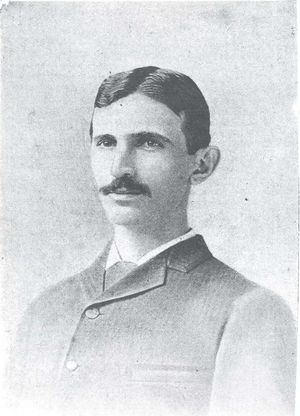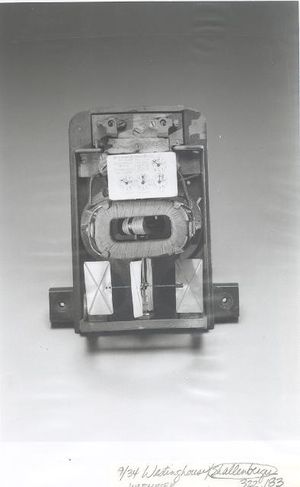Initial Tesla Polyphase / "Three-Phase" Alternating-Current Systems and Metering Development
Initial Commercialization of Direct-Current (DC) Applications
The late 1870s witnessed the initial commercialization and developing practical implementation of direct-current (D.C.) electrical power production and utilization. Prior to this, beginning with the first commercial electrical communications system developed for the Blackwall Railway telegraph installation of July 1840 - perfected by England's Cooke and Wheatstone - outside of its use in the realm of telegraphy, the use of electricity both in Europe and in America was primarily reserved to the halls of academia. Or, on the rare occasion outside of the commercial telegraph or the demonstrations given in prestigious academy and university lecture halls, the use of electricity to operate devices used commercially by industry or the public took place as a rather rarefied occurrence. As well, any such application prior to the late 1870s was always done via direct-current (DC) systems that relied on cumbersome inefficient batteries or on the few available hand crank apparatuses such at the Gramme generator or the more primitive Whimshurst electrostatic machine and generator.
Inventor Thomas A. Edison led in the development of the DC electric motor and incandescent electric light, the latter for which Edison was the inventive progenitor. The DC system of power distribution however was flawed, in that, like with William F. Cooke's initial telegraph electrical signal transmission experiments, the signal strength diminished over long distances. This necessitated the need and use of a electrical relay. As it came to be, after having met with America's Joseph Henry - who invented the relay, English telegraph co-patentee Charles Wheatstone provided the knowledge of the relay's function to partner Cooke. It was divulged to Cooke that to "step-up" the electrical signal to maintain signal strength, the use of finer coil windings needed to be employed over that of the thicker standard electrical telegraph sounder windings being utilized at the time. This modification to the standard form of telegraph transmitter/ sounder, into an electrical relay, would find that action induced using the finer coil windings would cause the mechanism to "trip" a relay switch which in turn would "step-up" the electrical signal strength and allowing it to maintain the telegraph signal over longer distances.
In the case of DC electrical power distribution, the advancement of a "three-wire" system over that of a "two-wire" system was developed by Edison in an effort to allow the electrical output of the DC generator to maintain current strength along the line as it traveled from the DC source dynamo generator to the load drawing customer instead of gaining resistance and sustaining voltage drop-outs as the distance increased between the central power station and the customer.
Introductory Development of Alternating-Current (AC) and Polyphase Electrical Systems
By the mid-1880s, initial European development spawned interest in what is known as alternating-current (AC) electrical power, where the power was produced from initially, a "two-phase" system of electrical production and distribution - and eventually of what became known as a "three-phase" or "polyphase system" of electrical generation and distribution.
This period of time in the history marking the rapid development of the electrical industry in the 1880's is often referred to today as the era known as the "War of the Currents." Alternately this period can also be referenced as the "War of Currents" or "Battle of Currents."
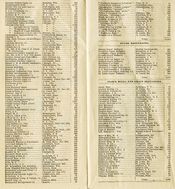
George Westinghouse and Thomas Edison had become adversaries over Edison's incessant promotion of direct-current (DC) electric power distribution of both the "central station" and "isolated plant" forms over that of alternating current (AC). At this time, the latter AC systems were being advocated by several European companies and the Westinghouse Electric and Manufacturing Co. based in Pittsburgh, Pennsylvania. It was this George Westinghouse founded company that would soon enough acquire many of the Serbian born Nikola Tesla's electrical patents pertinent to alternating current.
The AC polyphase system provided a more economical means of distributing electrical power, over that of DC power transmission. Polyphase systems utilized three or more energized electrical conductors that carry alternating currents having a definite time offset between the voltage waves in each conductor. It was found early on in its development that polyphase systems proved to be most effective for transmitting power to electric motors.
The most common example of the polyphase system today is the three-phase power system used for industrial applications and for electrical power transmission. There is a major advantage of three-phase power transmission - which uses three conductors, over that of a single-phase power transmission system - which uses two conductors.
The advantage of the "three-phase" over that of the "two-phase" electric system is that since the remaining conductors act as the return path for any single conductor, the power transmitted by a balanced three-phase or polyphase system, is exponentially three times that amount generated over that of a single phase electrical transmission system; however only one extra conductor is used. Thus, since only one extra conductor is used instead of two, a fifty percent (50%), or one and one half times (1.5x) increase in the production cost of the electrical transmission translates into a two hundred percent (200%) or three times (3.0x) transmitted electrical power increase.
Drawbacks of the Direct-Current (DC) Electrical Systems
The direct-current (DC) system however generated and distributed electrical power at the same voltage (120-220 v) as that used by the electricity recipient customer's lamps and motors. The DC systems also required the use of thick, more costly, thicker, and heavier shielded distribution wires and forced DC electrical generating plants to be located near the loads, i.e. customers.
In addition, for DC systems to maintain constant potential, electric dynamos were required to produce the constant potential all while utilizing circuits capable of causing small loss - which was difficult. Lamps rated at five or ten volts could be operated at only a few feet from the source of power without large line loss. It was either this or the conductor wires needed to be very heavy and hence, much more costly. For the low-voltage draw Edison lamps, the heavier wire would increase the practical operating distance to five hundred or a thousand feet. This proved a problem. However the capacity was then increased by Edison's development of the three-wire system and also the feeder-main system. These were merely stop-gap measures in the over-all picture of all things D.C. direct-current.
The permissible cost of conductor wire was generally reached within a mile's radius of a DC central station's output to make the system appreciably profitable over the long run. Four-wire and even five-wire systems and various systems in series enabled low voltage draw lamps to be served by circuits carrying now 300 or 400 volts or more. These were found however to be an unsafe and an unsuccessful advancement. Thus, DC systems were plagued by electrical distribution that basically seemed limited to a mile radius or less, except when utilization of the series system was employed and other means - but the 'gains' were still somewhat minimal compared to the effort and added expense outlay.
The use of central power stations for incandescent lighting, based on Edison's original N.Y.C. Pearl Street installation model that was brought into use first on September 4, 1882, therefore, seemed doomed to lighting only densely populated areas. With great dismay, in the 1880s, electrical industrialists and their agents would come to view electrical grid maps of large cities systematically showing areas a mile or less in diameter each burdened with its own central station. This was hardly a comforting image of the situation for those that understood the reality. To have a central station just to run say fifty or so large buildings or even 300 offices every half mile to a mile in radius made little sense.
Such implementation became impractical over time, for, as the need for widespread electrical power proportionately increased, such would mean more and more DC generating central stations would need to be built and put into operation in order to service a given and ever-growing densely populated area. All of this would eventually cause the system to be more and more cost ineffective to service the growing electrical load requirements. New construction of taller buildings in big cities requiring increased electrical loads built on land that was diminishing and at the same time increasingly costing more to obtain, all while more DC central stations were needed to be built to service the growing demand in a specifically defined constant space, and in a same given area where the specifically defined constant space in the form of basic 'land' increasingly became more and more unavailable. All of this offered densely populated areas that comprised cities a very limited DC 'shelf life.'
In the rural areas of America, where even up to the 1930s and early 1940s, both electricity and telephones were not very commonplace, DC current systems still enjoyed some widespread use. However, this was only for those fortunate enough to be able to afford such 'extravagances.' Older DC dynamos by Edison General Electric patented in 1889 were sometimes found to have been in use on rural American farms and country dwellings well into the 1940s!
With the development of a practical "step-up" and "step-down" electrical transformer systems in the 1880s, much like that with the development and employment of the Cooke and Wheatstone electrical "step-up" relay invented by America's Joseph Henry, AC electric power could be sent longer distances through thinner wire over that required for DC transmission, at a convenient high voltage, then reduced back down to a lower voltage that could be used by the recipient customer - all at a much less cost of production. All of this translated in to the fact that alternating-current AC electrical generating stations could be larger and cheaper to operate - and of course much farther apart. As well, conductive wires used for AC power distribution were thinner and much less expensive to manufacture and to employ into a network grid of electrical power transmission - over that of DC power generator systems.
The Advancement of Alternating-Current Systems by the Late 1880s
Alternating-current was first developed in Europe. This effort was due to the initial work in the 1850s by France's Guillaume Duchenne, who also, as known as the 'Father of electrotherapy and neuropathology.' Further progress was made in the 1870s by the Ganz Works, the company founded in 1844 by Hungary's Ábrahám Ganz. Sebastian Ziani de Ferranti of England further advanced AC development in the 1880s, along with France's Lucien Gaulard, and Italy's Galileo Ferraris. France's Lucien Gaulard and England's John Dixon Gibbs also made great contributions to AC development beginning in the early 1880s with their early work in developing experimental AC transformers.
Primary to the introduction and implementation of the AC electric systems, in 1883, during his time at the Ganz Works, a Hungarian named Ottó Titusz Bláthy invented the first perfected electrical "transformer" there. This was in following to Bláthy's initial experiments mounted in the company's development laboratory. In 1885, the Model "Z.B.D." alternating-current transformer came to be invented by three Hungarian engineers: Károly Zipernowsky, Ottó Bláthy, and Miksa Déri. The initials for each of the three men's last names formed the Z.B.D. name designation given to this first commercial AC transformer. The reliability of AC technology received impetus after an 1886 installation by the Ganz Works that electrified much of Rome, Italy.
Polyphase electrical power was found to be very useful in AC motors, such as that of the induction motor. In this instance a rotating magnetic field is generated. When a three-or-more-phase electrical supply completes one full cycle, the magnetic field of a two-poles-per-phase motor will have rotated through 360° in physical space. However electric motors with more than two poles per phase require more power supply cycles to complete one physical revolution of the magnetic field. This causes such motors to run slower. Induction motors using a rotating magnetic field were independently invented by Italy's Galileo Ferraris and also Nikola Tesla. The three-phase induction motor was developed by Mikhail Dolivo-Dobrovolsky in 1889.
Prior to this, all commercially produced motors were DC, utilizing expensive commutators and high-maintenance brushes prone to malfunction, and not usable for operation on an alternating-current network. AC polyphase motors on the other hand were simple to construct, were self-starting rather than requiring a starter capacitor or a smaller "exciter" motor, and produced little vibration compared with their DC single-phase motor counterparts.
In North America, George Westinghouse, the American entrepreneur and engineer who had invented, developed and commercialized the Westinghouse air brake that attained universal use on the US railroad systems - became intensely interested in AC power.
Around 1885 George Westinghouse began paying attention to the debate surrounding AC versus DC. He learned that AC was an instrument by which high voltage electricity could then be transformed into voltage for a more efficient operation of incandescent lighting and other electrical devices and could produce electricity more cheaply than the DC method of electrical power generation.
Westinghouse initially sent an investigator to England, where he ultimately learned of the newly developed invention and use of electrical transformers developed by the Ganz Works in Hungary. Westinghouse went on to acquire a number of patents and patent options, some of which included the Gaulard and Gibbs patents. These involved induction coils or “inductoriums,” which were primarily open magnetic circuit transformers.
Westinghouse, who had originally employed William Stanley, Jr. to develop incandescent lamps for Westinghouse at his Pittsburgh, Pennsylvania facility, now, in late 1885, advanced a contract for Stanley to work at an old rubber mill Westinghouse acquired in his Great Barrington, Massachusetts hometown. The following year, in 1886, Westinghouse founded the Westinghouse Electric and Manufacturing Co. and continued to invest in the new AC technology, all to develop an electrical distribution system incorporating step-up and step-down transformers of a new design that he hoped would become fully workable by late 1886.
Here at the old mill Stanley successfully constructed 19 transformers, each wound to reduce the 500-volt main line potential to low volts in their secondary circuits. It is interesting to note that these transformers differed from the Gaulard and Gibbs “inductoriums," as the Gaulard & Gibbs system was not self-regulating because its induction coils were wired in series.
Stanley created transformers that maintained a primary wound for a relatively high potential which in turn saw these primary terminals connected in parallel to a constant potential circuit that in turn was self-regulating. The use of a parallel circuit was the key here over that of a series circuit and Stanley's discovery of this effect appears in his notebook entry of September 18, 1883.
Further, the use of a closed magnetic circuit was applied to the making of the coils; thus making the proportions of the transformers remarkably similar to those of the modern “shell type” of electrical transformer. The very thought however of connecting a primary coil having a resistance of only one ohm between the mains of a 500 or even a 1000-volt circuit was so palpable a violation of Ohm’s Law that, at this time in the mid-1880s, it conversely rocked the convictions and very foundation of thought of those familiar only with the direct-current applications of the day. It was however the bold ideas of a handful of dedicated and daring inventors who took the first steps to this new AC world of understanding, of that which the world is now all so familiar.
Despite popular notions, this initial use of Stanley's AC transformers raised great promise and a Siemens machine was eventually imported by Westinghouse from England for tests at Pittsburgh; employed as a generator. Ultimately more Siemens generators were acquired by Westinghouse, erected in the spring of 1886 at the Great Barrington facility Stanley managed, and were properly connected to the series of transformers Stanley had just developed himself. This concerted effort formidably supplied some 25 stores and business establishments in Great Barrington with A.C. electrical service on a commercial basis. The plant successfully continued in operation for several months until the Siemens A.C. dynamo ultimately sustained great damage to its coils when a screw driver was accidentally dropped into the dynamo housing and wrecked havoc to the coil and armature windings.
The over-all success of this initial AC plant upstart operated by William Stanley helped paved the way to the commercial adaption and proliferation of the AC system by the Westinghouse Electric and Manufacturing Company.
Not long after the Siemens dynamo accident, Stanley left the employ of Westinghouse. Stanley and Westinghouse differed on a number of issues and actually, by 1890 - Stanley completely severed himself from Westinghouse to set out on his own A.C. systems - with great successes mounted by him in California. In 1886 however, Oliver B. Shallenberger, a former naval officer, took control of the AC project for Westinghouse and became its chief electrician.
After the accident incurred by the Siemens machine, a new alternator, originating from initial plans made by William Stanley, Jr. and further developed in detail by Westinghouse electrical engineer Oliver B. Shallenberger and the Swiss engineer Albert Schmid, was constructed in Pittsburgh. No longer would Westinghouse find the need to be reliant on imported AC technology and equipment. George Westinghouse was well on his way toward developing a whole new system of electrical generation on his own.
A full line of commercial apparatus was quickly designed and manufactured, and AC central stations suddenly began to appear, first at Greensburg, Pennsylvania - and then at Buffalo, New York. Two years after the start-up of the Great Barrington plant development arm, by 1888 there were about a hundred AC installations throughout several regions of the United States.
Within ten years of the 1886 company start-up, Westinghouse AC systems were found everywhere. The Edison General Electric Co. was formed in 1889 between Thomas A. Edison and Elihu Thomson, and quickly set about switching gears by entering into the development of AC power generation and distribution systems to augment their DC equipment line, all while quickly phasing out the necessity of providing DC current via central stations and dynamos run by steam engines.
Shortly after the Westinghouse Electric and Manufacturing Co. formation in 1886, Westinghouse's project engineer Oliver B. Shallenberger worked closely in developing the AC systems with electrical engineer Philip Lange, a German citizen living in Pittsburgh during his employ with the Westinghouse company.
Philip Lange is also credited with developing much primary apparatus that led towards the perfection of the Tesla Polyphase System of electrical generation that was under the tutelage of chief electrician Oliver B. Shallenberger at Westinghouse in the late 1880's.
Applicable AC Patents by Lange, Byllesby, and Shallenberger used towards Polyphase Systems creation
The meter herein pictured covered by Lange and Shallenberger patents include some of the following patents, while other patents by Lange or Lange and co-patentee Henry Byllesby pertain to other applications ultimately used in the Tesla polyphase system's development and application.
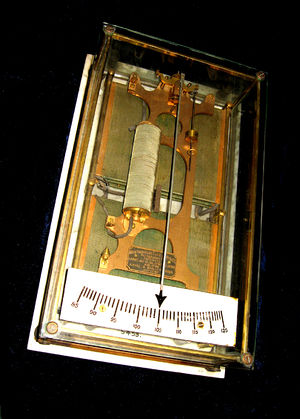
These patents are as follows:
Patent No. 366.374 - filed December 1, 1880 - granted July 12, 1887.[[1]]Inventors: Philip Lange and Henry M. Byllesby. Assigned to Westinghouse. Entitled: "A Circuit Controller for Electrical Circuits."
Patent No. 366,407 - filed December 2, 1886 - granted July 12, 1887.[[2]]Inventor: Philip Lange. Assigned to Westinghouse. Entitled: "Electric Switch." Draft shows a combination twist "T" handle / rocker line switch for commercial use in home and office lighting installations.
Patent No. 366,408 - filed December 2, 1886 - granted July 12, 1887.[[3]]Inventor: Philip Lange. Assigned to Westinghouse. Entitled: "Core for Electro Magnets and Method of Forming Same."
Patent No. 366,410 - filed January 21, 1888 - granted July 31, 1888.[[4]]Inventors: Philip Lange and Oliver B. Shallenberger. Assigned to Westinghouse. Entitled: "Electric Galvanometer."
Patent No. 386,992 - filed October 29, 1887 - granted July 31, 1888.[[5]]Inventor: Philip Lange. Entitled: "Galvanometer." Assigned to Westinghouse. Like the original Edison designed "chemical Meter" used to measure inline DC current, this AC patent by Lange employed the use of a light bulb as well in its design. The Edison "chemical meter" system was used to measure amperes per hour - so that the commercial user could be charged accordingly for usage. Prior to this, Edison billed users with a per lamp charge, a method which was not in any way accurate as to electrical consumption or load draw.
Patent No. 386,993 - filed January 21, 1888 - granted July 31, 1888.[[6]]Inventor Philip Lange. Entitled: "Galvanometer." Assigned to Westinghouse, the patent draft shows a meter indicator / coil arrangement attached to a AC electric dynamo and such embodies some characteristics of design incorporated in the Westinghouse meter pictured herein bearing the Lange and Shallenberger issued patents between 1887 and 1890.
Patent No. 434,151 - filed September 1, 1887- granted August 12, 1890.[[7]]Inventors: Philip Lange and Oliver B. Shallenberger. Assigned to Westinghouse. Entitled: "Switch for Electrical Circuits." The patent draft shows a combination three-conductor point knife switch for use in polyphase AC electrical systems.
Patent No. 434,154 - filed May 15, 1890 - granted August 12, 1890.[[8]]Inventor Philip Lange. Entitled: "Electric Indicator." Assigned to Westinghouse. The patent draft shows a meter/coil arrangement similar to the Westinghouse meter pictured herein bearing the Lange and Shallenberger patents issued between 1887 and 1890.
George Westinghouse Acquires Tesla Alternating-Current Patents
The singular pivotal point for George Westinghouse in his development of a practical AC system occurred in July 1888, when George Westinghouse licensed Nikola Tesla's U.S. patents for a polyphase AC induction motor and related transformer designs. As well Tesla was hired for one year to be a consultant at the Westinghouse Electric & Manufacturing Company's Pittsburgh labs. Tesla's AC motor and transformer designs were integral to maintaining a secure position supporting George Westinghouse's foothold in the then burgeoning AC electrical industry worldwide.
The effort to acquire the use of Tesla's patents had been spurred by the fact that Westinghouse had become nervous over hearing that Tesla's backers had been considering offers from another capitalist seeking to license Tesla's U.S. patents. Thus, Westinghouse concluded that he was best off by paying the rather substantial amount of money that was being asked to secure the Tesla license that July of 1888 as he had done.
Westinghouse Introduces O. B. Shallenberger's 1888 Patented AC Watt-Hour Meter
While at Westinghouse working on applications for AC power, Shallenberger by happenstance stumbled onto a solution for the problem of metering - which went far beyond the absurdness of Edison's ineffective early 1880s "chemical meter" and metering system. As Shallenberger was tinkering with an electric arc lamp in 1888, a spring broke loose and fell onto a ledge inside the lamp. Shallenberger saw that the spring had, most strangely, rotated as it fell.
Testing a hunch, Shallenberger discovered that the lamp’s spinning electromagnetic fields had caused the spring to turn as it dropped and came to rest on the lower surface inside the lamp. Analyzing what he had just then witnessed, within a few weeks time, Shallenberger applied the lessons learned to a very practical solution; designing a wheel that turned in relation to this rotational force he had come to witness firsthand. This development offered a means of measuring amperes per hour on an alternating current circuit. Such a development allowed for AC meter readings to be made so that accurate monthly billing of power usage could be advanced.
With the simple instance of a small dislodged spring falling inside of a AC-powered electric incandescent lamp, the invention of the AC watt-hour meter came about. The instance is marked by the August 14, 1888 patent no. 388,003 awarded to Oliver B. Shallenberger, assigned to the Westinghouse company. This invention clearly came at the right time and conversely just in time, all as the AC electric power industry would begin to develop exponentially at the dawn of the twentieth century.
Westinghouse Acquires Licenses to Other AC-Related Patents
As a added safeguard, Westinghouse also purchased a U.S. patent option on induction motors from Italian physicist and electrical engineer Galileo Ferraris in an attempt to own a patent that would supersede those developed by Tesla.
Westinghouse also acquired other patents for AC transformers from French electrical engineer Lucien Gaulard and British engineer and financier John Dixon Gibbs - the two who had combined their knowledge to develop the first AC step-down transformers as early as 1881. One such patent, U.S. RE11836 E, entitled "System of Electrical Distribution," filed on August 6, 1889 after being assigned to the Westinghouse company, was not granted until June 26, 1900. Prior to acquiring patents from Gaulard and Gibbs, Westinghouse had imported a number of Gaulard-Gibbs transformers for use with the Siemens dynamos he had been importing and testing. The transformers initially designed by William Stanley, Jr. for the Westinghouse company beginning in 1885, and later further designed by Oliver B. Shallenberger, were originally based on Gaulard-Gibbs A.C. transformer designs that the company had imported for testing.
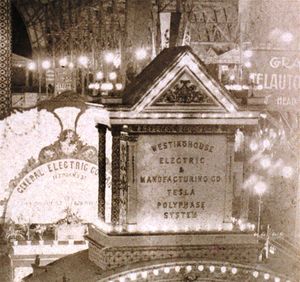
After winning the contract to provide electric power and lighting for the 1893 Columbian Exposition at Chicago, a massive state-of-the-art water turbine-driven AC power station designed predominately by Nikola Tesla began construction in 1895 at Niagara Falls. The generator station was later dedicated by Tesla himself at the opening ceremonies on January 12, 1897.
Westinghouse Introduces Shallenberger and Lange Three-Phase Polyphase System AC Line Galvanometer Indicator
The Westinghouse line galvanometer voltmeter shown here constructed under the combined Lange and Shallenberger patents of between 1887 and 1890, clearly show that the design is integral to handling electrical current developed and maintained under the Tesla Polyphase or "three-phase" system of electrical production and distribution. Looking close at the finely wound thin green wire coil system, one can immediately see the implementation of the "three-phase" concept.
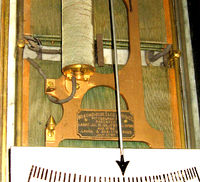
What can be seen is a total of seven coils in this particular Tesla Polyphase System Galvanometer / Voltmeter; but six of the seven coils are unlike coils that are of the familiar round cylindrical form.
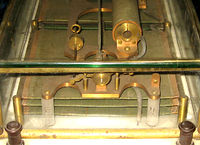
Looking close one can see two side by side tiers of three unusual completely flat coils each directly tier-mounted on top of each other that are each 6" long x 6" wide x 1/8" thick in size and wound with extremely thin fine green cloth covered wire. The six flat 6" x 6" x 1/8" coils comprise a total combined surface area of approximately 225 square inches.
Mounted offset above these two side by side tiers of three flat coils stacked above each, is a standard round cylindrical coil measuring a 1 1/4" in diameter and 4 1/2" long. This coil has a hollow core meant to accept a electromagnetic core. The coil is also wound with the same thin fine green cloth covered wire as that of the flat coils below it. This round cylindrical coil however is lacking the suspended electromagnetic core that would suspend from the machined brass balance arm to which is attached the galvanometer indicator's needle. The needle indicator reads "85" up to "125" - which offers a given meter current line measurement usefulness translating to between 85 volts and 125 volts; for a electric system capacity or output rating with in such voltage parameters.
The whole delicately machined lacquered brass main frame assembly for the entire indicator / galvanometer / meter seen mounted above the two assembled tiers of flat three each 6" x 6" x 1/8" coil assemblies - can be seen mounted at four points atop four cylindrical frosted possibly glass or stone base insulating pillars or columns that attach the main brass frame assembly to the 17" long x 10" wide x 1" thick insulating marble base found below said assembly.
This Westinghouse meter indicator, totally encased in glass on five sides, bears a serial number "5453" and survives singularly as one of the most graceful and beautiful AC Polyphase System components from the earliest days of AC invention, development, perfection, and proliferation of the Tesla Polyphase System or "three-phase" system of AC electrical generation - manufactured in the late 19th century by the Westinghouse Electric and Manufacturing Company.
